Chess Set 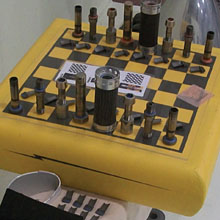
(Please click on any image to enlarge it.)
Game Board
Measuring just over 20 inches square by 5 inches high, it is a Cessna 172 wing strut ($1,500), with a cross section included to show your friends. It is covered by fabric (swatch included) remaining from a re-cover project of an Aeronca Chief, rib-stitched as on an airplane, and painted in J-3 Cub yellow ($100/gallon). The protective plastic is the same as a side window of a Cub.
The back is a sheet of aluminum ($40) from a Cessna 310 rebuild project after a nose landing gear malfunction, with a cowl access door from a single engine Piper($90), assembled by a retired Air Force C-130 crew chief ($priceless).
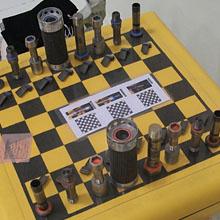 The inside is covered with felt (the only non-aero material) for storage of playing pieces. The inside is covered with felt (the only non-aero material) for storage of playing pieces.
Game Pieces
King - A jet fuel filter used on Pratt and Whitney PT6 turbine engines, changed every 1,000 hours ($100.00).
Queen - A Wing attach bolt from a KingAir forward wing spar torqued to 25 foot/pounds, replaced every 5 years ($600.00).
Bishop - A Wing attach bolt from a KingAir aft wing spar torqued to 600 foot/pounds, inspected every 5 years, replaced at 15 years. ($600.00 for the bolt, $1,200.00 for the nut).
Knight - A spark plug from an IO-540 rated at 260 horsepower for about 400 total hours ($30.00).
Rook - A valve lifter from the above engine ($150.00).
Pawn (or checker) - Each is a "hot section" turbine blade from a PT6-21, derated from 750 horsepower to 550 continuous horsepower for use on the Beechcraft KingAir C90 series turbo-prop airplanes. At cruise power, a series of 56 of these blades spin on a hub at up to 38,000 RPM (633 laps per second), clearing the inside of the combustion chamber by 0.001 to 0.003 inch, at a brief maximum temperature of just over 1000 degrees C (1,832 F) or 695 C (1,283 F) continuously for up to 3,600 hours.
Trivia: 38,000 RPM x 60/hr = 2,280,000/hr x 3,600 hrs = 8,208,000,000 turns, plus taxi and idle time, between overhauls.
More trivia: the tip travels just over 28 inches per revolution x 38,000 RPM = 1,064,000 inches/minute = 88,666.6 feet/minute = 16.8 miles/minute x 60/hr = 1,008 miles/hour x 3,600 hours = 3,628,800 miles between overhauls + ground time.
New blades: $40,000.00 per set, $714.29 each
(Variations may also be created using customer-supplied airplane parts.)
MSRP: $1,300.00 USD (ORO)
Floor Lamp 
(Please click on the image to enlarge it.)
The Base - A Goodyear wheel and brake disk are mounted atop a Cleveland brake disk, all from KingAir 90 series main landing gear assemblies.
The Pedestal - Three wing ribs, built additionally to a Stearman rebuild project, hold a center post tube of metal used in fuselages of fabric-covered airplanes. They are held at the top by an Adel clamp used to hold cables and tubes from chaffing and flexing while airborne.
The Shade - A spinner from a Piper Navajo.
With the exception of a cork pad under the base, the electrical and lampshade mounting hardware, all items are aeronautical.
MSRP: $1,313.13 USD (OBO)
Jewelry 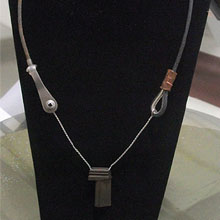
(Please click on any image to enlarge it.)
Neckwear
The pendants are Jet engine turbine blades of various sizes, attached to lengths of control cables by Aircraft Safety wire, allowing you to choose the length you want. The engine make and model of the larger blades are unknown, but the small blades are "hot section" turbine blades from a PT6-21.
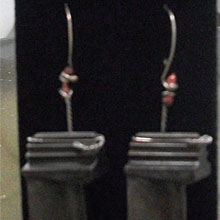
Ear Pieces
Each is a "hot section" turbine blade from a PT6-21, derated from 750 horsepower to 550 continuous horsepower for use on the Beechcraft KingAir C90 series turbo-prop airplanes. They are attached by Aircraft Safety wire to an ear hook supplied by a local jewelry maker.
New blades: $40,000.00 per set of 56, $714.29 each
MSRP: $99.00 USD (Female pilot's organization: The 99's)
13 Airfoils 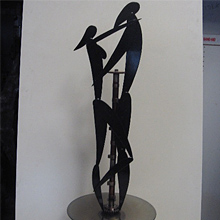
(Please click on any image to enlarge it.)
This piece brings together my fascination (obsession?) for airplane wings and my wife's favorite number.
The base consists of a propeller hub from a constant-speed prop holds a plexiglass Polaroid disc used in KingAir passenger windows. Another disc can be turned to block most of the sun, but they eventually form bubbles if left too long in that position.
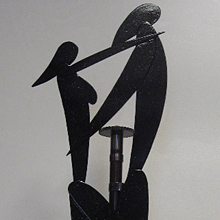
The airfoils could represent many, from "F"-series military to imaginary, and they are supported by a cam-shaft from a 260 HP Lycoming IO-540 engine of a Piper Comanche.
The 13 airfoils may be sold separately, and in custom colors of your choosing.
Price variable with content changes
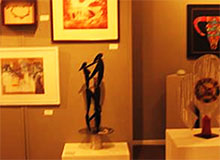
Update: Here's a shot of the 13 Airfoils as featured at the Chico Art Center in October of 2013.
Conference / Formal Dining Table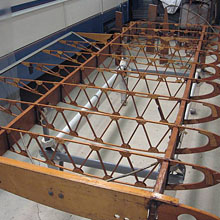
(Please click on any image to enlarge it.)
The Wing - The wing is from an Aeronca as it was being rebuilt by a local pilot. When he and the restoration specialist pulled the fabric from it and looked at it closer, they decided to rebuild the whole wing and this part was to be trashed. But I got a call asking if I wanted it. 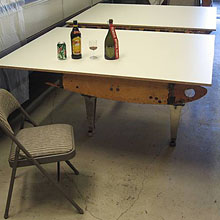 With some hesitation due to size, I said "maybe." It turned out they had to cut one spar to remove one of the strut fittings, so, by cutting the other, it fit in my van and I brought it to my shop. After some study, I cut the other section into other projects. But when I started cleaning this part, I just couldn't bring myself to cut it up, and this is the result. With some hesitation due to size, I said "maybe." It turned out they had to cut one spar to remove one of the strut fittings, so, by cutting the other, it fit in my van and I brought it to my shop. After some study, I cut the other section into other projects. But when I started cleaning this part, I just couldn't bring myself to cut it up, and this is the result.
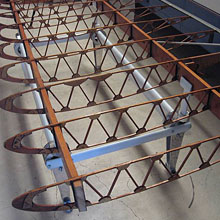 The Top - The top is plywood cut to the shape that glass might be if desired. The size is 59" by 106". A quote from a glass vendor came in at just under $500.00 and 280 pounds. The Top - The top is plywood cut to the shape that glass might be if desired. The size is 59" by 106". A quote from a glass vendor came in at just under $500.00 and 280 pounds.
The Legs - The polished legs are the part of main landing gear that pivots to bring the wheel and strut into the wheel well of KingAir 90 series airplanes (new: $6,000.00).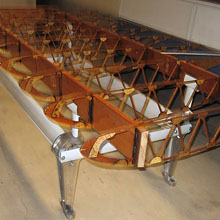
Support - The white bracing between the legs and the supports for the wing section are made of wing lift struts from various high-wing airplanes.
Price available upon request
Wall Clock 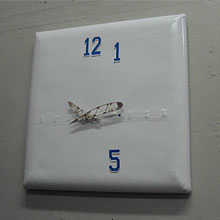
(Please click on the image to enlarge it.)
The face is fabric from an Aeronca Chief rebuild project stretched over a frame of wing struts and rib-stitched to a movement support as it would be to an actual wing rib. The numerals are the only ones I could think of that in some way apply to aviation and still be in a clock-face position (121.5: the emergency frequency). The hands are miniatures of wing ribs simulating those of an Acrosport.
MSRP: $99.00 USD (Female pilot's organization: The 99's)
My $5 Million Art Project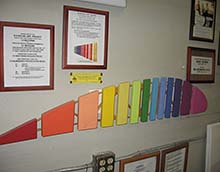
(Please click on any image to enlarge it.)
On the paper above my art to the right is the piece that originally ignited my creative interests; "Why can't I do something like that, but with an airplane-related twist?" I saved an article from Arts and Antiques magazine about this work that consisted of 13 canvas panels titled "Spectrum 13" which sold at auction for $5.1+ million. 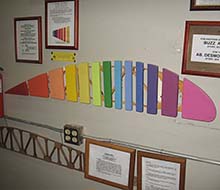 The fact that it had 13 panels got my attention because my wife claims number 13 as her lucky number (she bought her first car in the 13th of the month, it showed 13 miles on it, and it took 13 gallons to fill it), and that is why I now try to use that number in as many of my pieces as I can. The fact that it had 13 panels got my attention because my wife claims number 13 as her lucky number (she bought her first car in the 13th of the month, it showed 13 miles on it, and it took 13 gallons to fill it), and that is why I now try to use that number in as many of my pieces as I can.
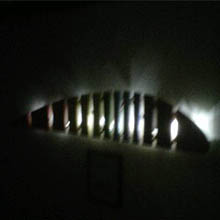 I made my segments in the shape of an airfoil and, while I was doing that, figured out how to make the circumference of each almost the same, and using an aeronautical chart plotter, shown in the photos of the piece hanging in my shop, as a measuring device. This made each segment 144 nautical miles around, regardless of shape. Then I mounted the pieces on a simulation of a wing rib, and added a set of small lights for back-lighting. I made my segments in the shape of an airfoil and, while I was doing that, figured out how to make the circumference of each almost the same, and using an aeronautical chart plotter, shown in the photos of the piece hanging in my shop, as a measuring device. This made each segment 144 nautical miles around, regardless of shape. Then I mounted the pieces on a simulation of a wing rib, and added a set of small lights for back-lighting.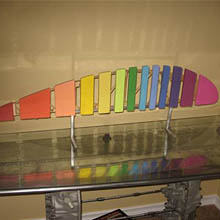
Then I added a stand and photographed it on that stand, placed on another of my pieces, the
hall / entry table.
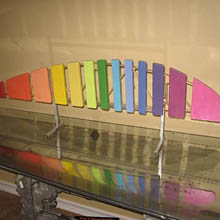 I will accept orders for variations of this piece, such as using a customer-provided wing rib as a mount for the segments, different colors, add a clock, whatever. But there will only be 12 more pieces, one is spoken for, and I get to keep the 13th. I have another cut to the shape of an Aeronca rib, with the segments 150 miles around, but facing right to left, and primed - ready for color to order. I will accept orders for variations of this piece, such as using a customer-provided wing rib as a mount for the segments, different colors, add a clock, whatever. But there will only be 12 more pieces, one is spoken for, and I get to keep the 13th. I have another cut to the shape of an Aeronca rib, with the segments 150 miles around, but facing right to left, and primed - ready for color to order.
Coffee Table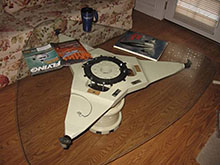
(Please click on any image to enlarge it.)
The main section of this piece is a rotor head from a Eurocopter which had reached its flight-hour limit. 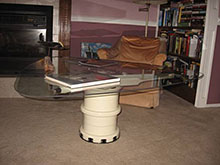 The pedestal is a stack of Beech KingAir main wheel halfs upon which the rotor is positioned by the attached brake disks. The glass top measures 51 inches triangular, and sits about 18 inches high. It is supported by rubber cowl attachments common to several Cessna models. The pedestal is a stack of Beech KingAir main wheel halfs upon which the rotor is positioned by the attached brake disks. The glass top measures 51 inches triangular, and sits about 18 inches high. It is supported by rubber cowl attachments common to several Cessna models.
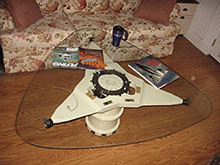
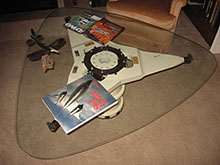
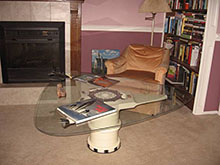
Canvas Pieces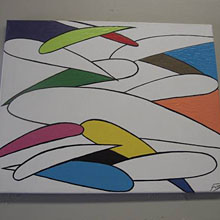
(Please click on any image to enlarge it.)
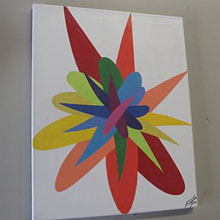 These pieces came to mind from seeing random patterns in stained glass. As with many of my other items, there are 13 airfoils and 13 colors. These pieces came to mind from seeing random patterns in stained glass. As with many of my other items, there are 13 airfoils and 13 colors.
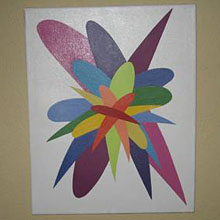
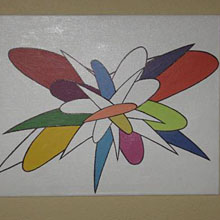 This one on the left was part of a demonstration at Chico Library's Lunch at the Library program for kids. So I got 13 of them to choose which segment to put the next color into. This one on the left was part of a demonstration at Chico Library's Lunch at the Library program for kids. So I got 13 of them to choose which segment to put the next color into.
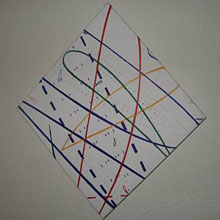
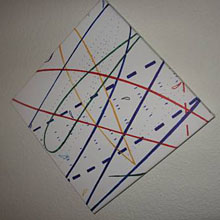 This one is 13 Sharpies, and can be hung from any of its corners or sides. This one is 13 Sharpies, and can be hung from any of its corners or sides.
This one is a sky blue field with 13 materials in airfoil shapes, including driftwood, rubber, tin, asphalt, and plywood (sold - next one may be somewhat similar).
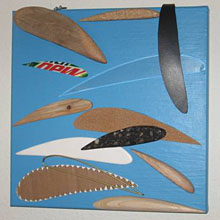
Hall / Entry Table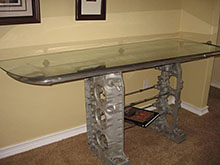
(Please click on any image to enlarge it.)
The glass top of this table rests on 3 engine mounts common to many light airplane engines, but have become leveling devices and cushions for the glass upon the rounded surface of the Beechcraft stabilizer. Also included are washers (actually for spinner attach screws) to cushion the glass from rivet heads. 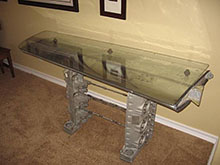 The stabilizer is polished aluminum with other fittings and gaskets left in place as produced by the factory, and includes evidence of hail damage and a long wait in a salvage yard so it could be re-purposed as a conversation piece and cared for by an airplane enthusiast. The stabilizer is polished aluminum with other fittings and gaskets left in place as produced by the factory, and includes evidence of hail damage and a long wait in a salvage yard so it could be re-purposed as a conversation piece and cared for by an airplane enthusiast.
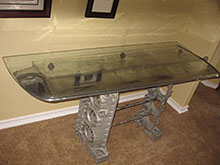 These parts rest on non-skid pads atop two engine halves from a Continental O-470 that performed well past its expected life in a Cessna Skylane. The halves are stabilized by through-bolts which originally held the halves together. The bottoms of both engine halves faced with cork to prevent scarring of tile floors. These parts rest on non-skid pads atop two engine halves from a Continental O-470 that performed well past its expected life in a Cessna Skylane. The halves are stabilized by through-bolts which originally held the halves together. The bottoms of both engine halves faced with cork to prevent scarring of tile floors.
The glass measures 70 3/8 inches on the longest side by 26 1/8 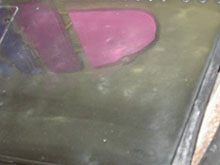 inches at the widest point, is shaped slightly larger than the polished stabilizer, and sits 33 inches above the floor. The space between the engine halves may be from 21 to 25 inches and could become small shelves, if desired. Total weight is about 135 pounds. inches at the widest point, is shaped slightly larger than the polished stabilizer, and sits 33 inches above the floor. The space between the engine halves may be from 21 to 25 inches and could become small shelves, if desired. Total weight is about 135 pounds.
This last photo was an attempt to show how polished the aluminum is, but the glass reflected too much.
Mural of Lear 35-015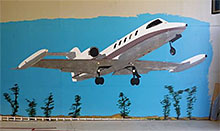
(Please click on any image to enlarge it.)
This piece was done just to see if I could do it. It is done on a wall of a storage / shop unit that I rent near the Chico Airport. That would actually be me in the co-pilot seat coming off a private ranch near Orland, CA. 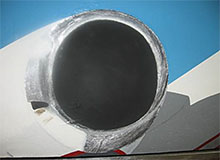 It measures 10 feet high by 19 wide and is house paint, etc., on drywall.
Prints are available ($99 + shipping) and measure 18" x 32" on 24" x 36" stock for framing. The prints include only a small strip of
floor, with the right side and top adjusted to all blue.
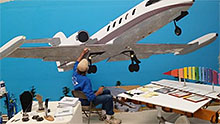
Let's talk about doing a mural of your favorite plane!
This last photo is me doing the final touches when a friend shot this before I knew he was there. It is during a Chico Art Center Open Studios event.
Enguijulator, Paperweight, or...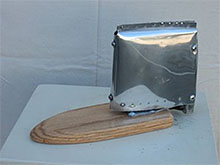
(Please click on any image to enlarge it.)
This can be a paperweight or whatever you want it to be!
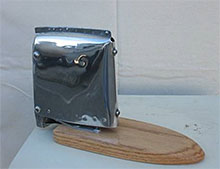
It is a control surface counterweight that was still on a Beechcraft stabilizer acquired from a salvage facility. It is mounted on its hinge and attached to a piece of aerodynamically-shaped oak. The whole assembly stands 6.5 inches high, is 3.5 inches wide, and 11 inches long, and weighs approximately 3.5 pounds.
Mandala 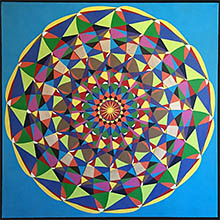
(Please click on the image to enlarge it.)
IT’S ALL JUST 5 AIRFOILS
(wing cross-section shapes)
To start, find 4 rings of white sections - these are the noses of the airfoils, except the outer ring where each is the nose of two airfoils, one being a radial, the other a border.
There are 16 (32, outer) airfoil noses in each ring which adds up to 80 airfoils.
The way that they intersect creates 74 sections in each of the 16 segments, which adds up to 1,184 sections.
The background is sky blue, as a tribute of gratitude to where I spent over 20,000 hours during a 43-year career which I didn’t even know how to think could be possible when I was a kid (that’s 465+ hours per year; 1 1/4 + per day!!).
Since this one was sort of a learning project, it is priced accordingly, and then next can be made to your specs. The view shown on this website is a 48" x 48" canvas.
Prints of this one are also available.
Aviator's Goddess 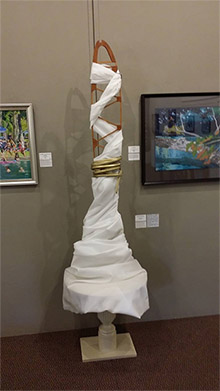
(Please click on the image to enlarge it.)
This is Pleoght, (silent P; Grk, le-uft; Eng, lift) Goddess of aviators, conqueror of the underworld demon known as Gravity. She is personified by a Stearman wing rib. She was first observed by bird watchers and early glider experimenters, but became prominent with the addition of engines and propellers. This exposed her powerful soul mate, the god Thrust1, himself the antithesis of Dhraggue, the parasite2 ironically induced3 by both of them.
She has a gown of Ceconite (an aircraft covering) and her belt is a door gasket which inflates to hold the pressurization of higher flying aircraft.
She rises to 87 inches from the floor, upon a pedestal with a platform which was a rotor head cover on a Eurocopter.
- 'Ahem'; but then, of course!
- Parasite drag: skin friction, antennas, rivets...
- Induced drag: a product of wing angle to relative wind.
Photo at Chico Art Center for Open Studios tour, October 2015.
Un-Named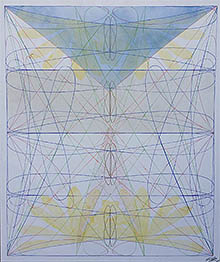
(Please click on any image to enlarge it.)
Un-Named - Please Send Suggestions!
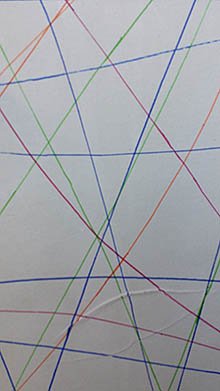
These are tracings of 6 different airfoil shapes, each its own color (listed on the back *), totaling 104 tracings in geometric patterns. They are on a canvas measuring 60" x 48".
| * |
Blue |
Cessna 172 wingtip |
24 |
| |
Green |
Ogar motor glider |
8 |
| |
Red |
Stearman |
4 |
| |
Yellow |
(freehand pattern) |
36 |
| |
Puce |
common Clark Y |
16 |
| |
Gold |
B-17 scale model |
16 |
| |
|
|
104 |
Airplane Portrait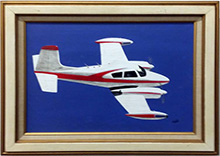
(Please click on the image to enlarge it.)
During the take-off to return home from a visit with relatives, one of the relatives took a photo with an iPhone and emailed it to the owner/pilot, who emailed it to me.
Let's talk about something you may have imagined that may be similar. The frame is a spare I had handy; you can do what you wish with framing.
Landing Tire Mark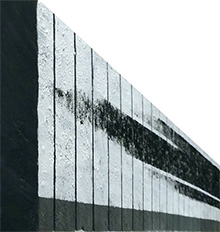
(Please click on any image to enlarge it.)
Hey, now. You gotta stay a bit sharp to occasionally operate a 10,000+ pound gross weight, 8 passenger turbo-prop from airports less than 3,000 feet long. So on empty returns to Chico, for touchdown accuracy practice, I would land the main wheels on one of the large white rectangles abeam the approach path indicators*, where the glide slope meets the runway. One seemed like an unusually nice landing and next time out I saw the black tire stripe. So I asked the city airport maintenance guy if there was a chance I could get out there to take some pictures of it.
* They are 150 feet long and at about 70 MPH (102.666 feet per second) they go past in just under 1.5 seconds.
This piece is meant to look like I got out there with a masonry saw and cut out that section of runway to keep it for myself.
Then I got to thinking about the poor tire (please check my math):
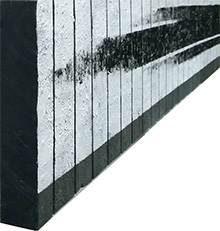
- Tire circumference = 6 feet 6 inches
- Actual length of mark = 18 feet
- Thus nearly 3 turns were needed to get from zero to about 61 knots (70 MPH)
- To go 18 feet at 70 MPH:
- 60 MPH = 5,280 feet / minute, divided by 6 = 880, times 7 = 6,160 feet per minute at 70 MPH
- Divided by 60 = 102.666 feet per second
- 18 feet at 102.666 feet per second = less than 1/5 of a second
- 6,160 feet per minute at 6.5 feet per turn = 947.7 RPM = 15.8 laps / second
- So the tire must turn just under 3 times in 1/5 of a second to reach 947.7 RPM
|

And that is for a good landing!
This piece is 90.5 inches long by 12.75 inches; the actual mark was nearly 18 feet long.
13 Wing Ribs (Mobile)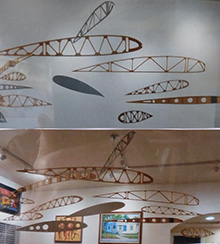
(Please click on any image to enlarge it.)
The photo with the blue background below is at the Chico Art Center. The one to the right is installed in the collector's home.
It required a space of 6 feet high by 20 feet diameter to move freely.
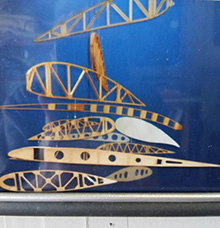
The ribs are:
- Piper Super Cub (metal, top)
- Wright Flyer (long, thin)
- Shoestring (racer)
- Stearman
- B-17
- Piper Cherokee
- Cessna 172
- Heath Parasol
- Aeronca
- Piper J-3 Cub
- Ogar motor glider (solid, white)
- One other that I don't recall
|
If you want one similar, you may send pictures or actual ribs and we'll go from there.
Interactive Panels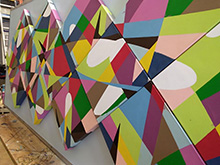
(Please click on any image to enlarge it.)
What started as one idea became another, ending up with an explosion in a kaleidoscope factory. I used 13* diverse wing cross-sections (airfoils), rearranging the panels as I traced each one to create a random bunch of segments and added colors (13)* (plus white for leading edges and black for trailing edges).
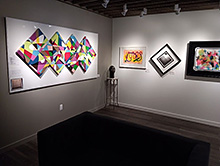
| To show it in the Mac Gallery in Detroit the director chose to attach magnets to each canvas and use a metal panel as shown in the photos. There is also a metal stand which can be used on a table or shelf, and which I will upgrade if needed.
|
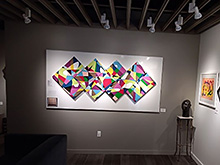
| The 7-panel piece is an experiment to see how it might work and is ready to ship with the stand. The airplanes used are J-3 Cub, Lear 35, BT-13, and B-17. |
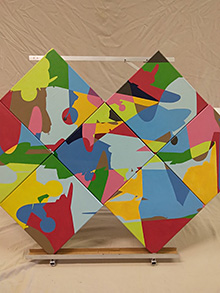 |
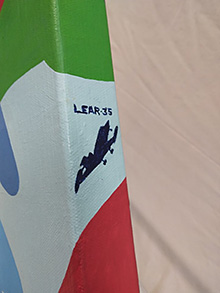 |
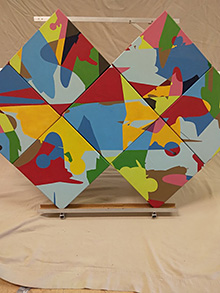 |
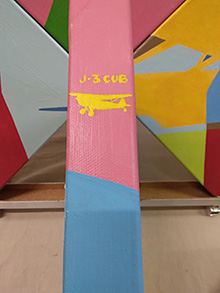 |
I've also been working on a 10-panel configuration. This one is in progress:
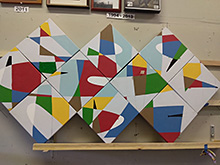
|
Current options for internactive panel:
- I would enjoy working with someone else's choices of airplanes or wing shapes or combinations
- What seems to be working would be with 7, 10, or 13 canvases but let's talk or text
- Also there are a couple of aviation education organizations that I would like to work with such as EAA and 99s
|
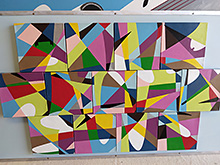
For the 13-panel series, it can have 4 corners and 4 sides in a square presentation. I thought it would become 8 options for rearranging:
- Wright Flyer
- Steadman
- J-3 Cub
- Cessna 172, Piper Cherokee
- Shoestring (racer), Ogar (motor glider)
- B-17 , Supercritical wing
- Aeronca Champ, 2/3 scale P-51
- Lear 35, Ford Trimotor
Being appraised, but all offers considered.
* 13; Judy's favorite number; bought her first car on Friday the 13th, with 13 miles on it, and it took 13 gallons to fill it.
|